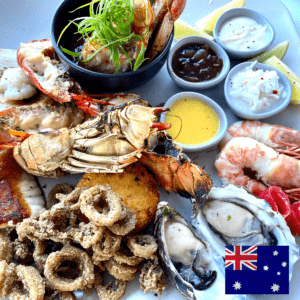
This complete guide covers the signature dishes and native ingredients that define Australian food culture. If you’re a food lover, planning to visit Australia soon, or looking to explore new cultures and flavors, this article will be your best guide to Australian classic cuisine.
Historical Influences on Australian Food
The historical influences on Australian food have created a culinary scene that is unlike any other on earth. Australian cuisine’s history starts with the Aboriginals of the continent, who had thousands of years to develop food collection and processing techniques, many of which are still used by contemporary chefs.
The later arrival of British colonizers altered the food scene radically, generating various types of European food and leading the way for the country to establish new culinary traditions. They introduced European cooking techniques, food grown from the Western country but not native to Australia, such as meat pies, roast dinners, and tea.
However, it was the post-World War II immigration boom that really changed Australian food culture forever. Subsequent waves of migrants, especially from Southern Europe and Southeast Asia, along with a small number from the Middle East, brought new flavors, ingredients, and cooking techniques that were slowly accepted or customized into Australia’s ever-evolving food repertoire.
Classic Australian Dishes
Meat Pies and Sausage Rolls
You’ve probably heard of meat pie, which is minced beef and gravy in a handheld pastry. First introduced in colonial days, meat pies are now a staple Aussie snack often eaten at sporting events or as an easy lunch. There are equally as many meat pies in bakeries across the nation as sausage rolls, another pastry-wrapped meat delicacy.
Fish and Chips
Rich in British heritage and a coastal lifestyle, fish and chips are a national favorite for takeaway. They are usually made of battered or deep-fried fish and served with extra thick-cut fries. Fish and chips are best enjoyed on the beach, and every coastal town will claim to make the best version of this wonderful dish.
Barbecue (The Aussie “Barbie”)
The BBQ is an Australian ritual and a way to cook. An iconic Aussie barbecue could include “snags,” a term for sausages, lamb chops, steak, and seafood, usually teamed with salads and bread. The phrase “throw another shrimp on the BBQ” might be a stereotype, but it gets at how central this form of cooking is in Australian culture.
Roast Lamb
With Australia’s proud tradition of sheep farming, a good roast lamb has a special place in the nation’s culinary heart. Commonly eaten as a part of a Sunday roast or other special meal, it’s usually seasoned with rosemary and garlic and served with roasted vegetables and gravy. This dish is famous both at home and abroad due to the quality of lamb produced in Australia.
Seafood in Australian Cuisine
Barramundi
The king of Australian fish, Barramundi, is famed for its delicate buttery flavor and firm texture. It’s great for grilling, pan-frying, or baking. A firm favorite among Aussie hunters or anyone seeking that quintessential Australian seafood experience, today, Barramundi is enjoyed by more home cooks.
Sydney Rock Oysters
Sydney Rock Oysters are native to the east coast of Australia and are a prized delicacy. They have a unique briny sweetness that locals like to slurp fresh with just a squeeze of lemon or some mignonette sauce. Their salty-sweet flavor is very distinctive, and they’re a seafood market staple, especially in New South Wales.
Moreton Bay Bugs
These aren’t insects, as the name would suggest, but a type of slipper lobster found in the waters surrounding Queensland. Moreton Bay bugs have a sweet, subtle flavor that’s often compared to lobster or crab. They’re either grilled or barbecued, served with garlic butter, or in seafood platters.
Prawns
Although “shrimp on the barbie” became a global catchphrase, Australians always refer to them as prawns. Whether in a seafood salad or on the Christmas table, these meaty crustaceans are gobbled up from the grill. Tiger and King prawns are two popular varieties.
Conclusion
The multi-layered story of traditional Australian cuisine reflects the continent’s distinctive past and an ever-changing melting pot of global flavors. Reflecting those ancient Indigenous food practices, the hearty classics of the early settlers, and ensuring home-cooked comfort in modern multicultural Australia, history is on every plate, including Australian produce.
With the rising popularity of Australian cuisine worldwide, what we know is that it shines because of its diversity and versatility. From backyard barbecues to fine dining, Australian food has a way of catering to all tastes with an unmistakable Down Under twist.